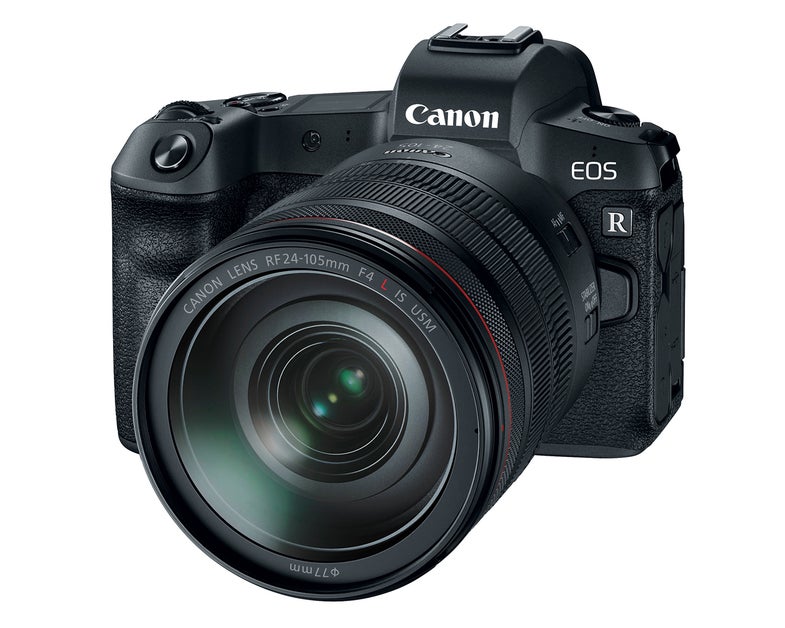Canon’s EOS R full-frame, mirrorless camera system: Everything you need to know
The company’s long-awaited pro-grade mirrorless is ready for your old lenses.

We may earn revenue from the products available on this page and participate in affiliate programs. Learn more ›

Canon EOS R full-frame mirrorless camera
After months of rumors, Canon, one of the world’s most well-known DSLR makers, has finally announced the arrival of its pro-grade full-frame mirrorless camera system. The EOS R system is a huge step for the brand—as they were the last major DSLR maker to enter the full-frame mirrorless market. The EOS R features a newly redesigned RF mount with a 20mm flange distance and the same 54mm mount diameter as the brand’s EF mount cameras. The new mount also features a 12-pin communication system between lenses and the camera body for faster and more precise performance.
This new system isn’t meant to replace the company’s well-established line of DSLR cameras though, rather the EOS R was built to seamlessly integrate with Canon’s massive selection of EF, EF-S, TS-E and MP-E lenses. This is possible thanks to the introduction of three new mount

Canon EOS R full-frame mirrorless camera
Here’s everything you need to know about the system at a glance:
Sensor:
-The EOS R uses a 30.3 MP CMOS sensor with an ISO range of 100-40,000 (expandable to 102,400)
-It’s powered by the the latest image processor, DIGIC 8, which enables shooting up to 8fps
Design:
-The lens mount is 54mm (the same as the EF cameras) with a flange distance is 20mm. EF, EF-S, TS-E and MP-E lenses are accepted with a mount adapter
-A single UHS-II SD card slot
-Weather and dust resistant body
-USB 3.1 in-camera charging
-Built-in Bluetooth and WiFi for easy sharing
Autofocus:
-Dual Pixel COS AF system
-5,655 manually selectable AF points
-Can focus in as little as 0.05 seconds with the new 24-105mm IS USM lens
Displays:
-The eyepiece has a EVF with 3.69 million dots
-Main display is a vari-angle touchscreen

Canon EOS R full-frame mirrorless camera
Lenses and Adapters:
-New lenses will use the R mount
-Four new lenses: RF 28-70mm F2 L USM, RF 50mm F1.2 L USM, RF 24-105mm F4 L IS USM and RF 35mm F1.8 Macro IS STM
-Three new lens mount adapters: EF-EOS R, the Control Ring mount adapter and the Drop-in Filter mount adapter
Pricing and Availability:
-The EOS R system will be available in October for $2299 for body only or $3399 when bundled with the new RF 24-105mm F4 L IS USM lens
-The RF 50mm F1.2 L USM will be available in October for $2299
-EF-EOS R and Control Ring mount adapter will be available in October for $99.99 and $199.99
-RF 28-70mm F2 L USM, RF 24-105mm F4 L IS USM and RF 35mm F1.8 Macro IS STM will be available in December for $2999, $1099 and $499.99
-Drop-in Filter mount adapter will be available in February 2019 for $399.99 with variable ND filter or $299.99 with a circular polarizing filter

Canon EOS R full-frame mirrorless camera
We got a bit hands on time with the cameras shortly after the announcement and our first impressions is that this is going to be a very nice system to shoot with and one that should give Canon users much of what they wanted. It’s a compact design that will be fully functional with the brand’s existing lenses. The camera feels solid—a bit larger than other mirrorless systems, but certainly less bulky than a DSLR. The menu system and controls are very similar to the brand’s 5D system, with the introduction of a few new controls. The layout feels fairly ergonomic, even with a few familiar settings being shifted around.
We did find it a bit odd that there is only one SD card slot instead of a pair, since most pros prefer to shoot to a pair.
We’ll be spending some substantial time with this new system over the coming days. Look for our hands-on review and sample image galleries soon.
